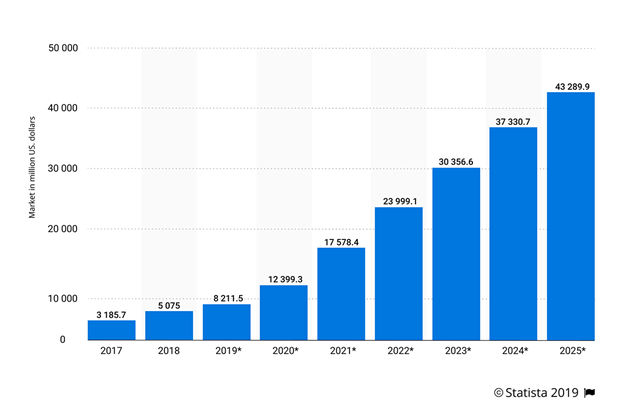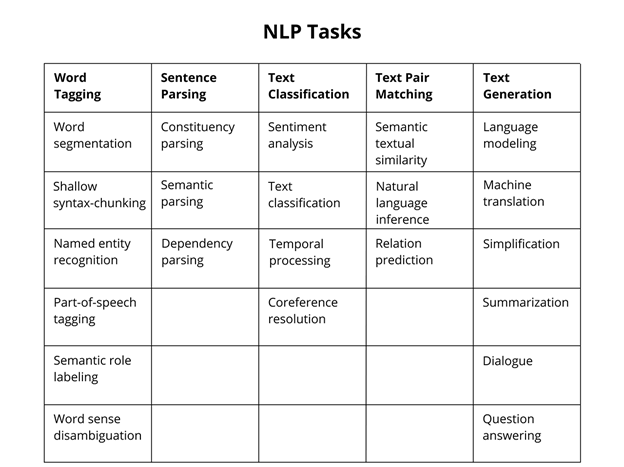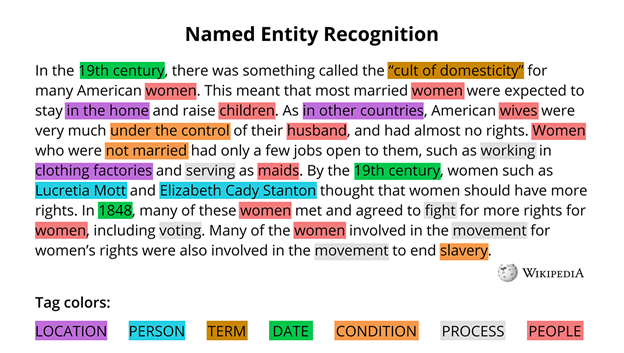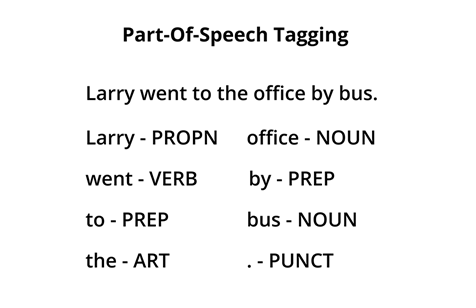AI-powered human-to-machine interactions are nothing new in the market now. It is widely used in almost every sector from kids' interactions to space research. Public organizations and businesses have been applying data science and machine learning technologies for a while. One of the quickest evolving AI technologies today is natural language processing (NLP).
A 2019 Statista report reveals that the NLP market will increase to 43.9 billion dollars by 2025.

*Expected revenues from the natural language processing (NLP) market worldwide from 2019 to 2025 (in million U.S. dollars)
Clearly, many companies believe in its potential and are already investing in it. Here are the most common NLP use cases in business:
But why is NLP becoming so popular year-over-year? And what might that mean for businesses? These types of questions are common. In this article, we are going to take a deep dive into NLP, its use cases, and other relevant information that you may find useful.
Natural Language Processing and How Does It Work?
In simple terms, natural language processing is AI technology that recognizes and understands natural human languages. Written or spoken human speech is converted into a form that computers can understand through NLP techniques.
Most of us use NLP business applications every day without even knowing it. Spell-checkers, online search, translators, voice assistants — almost all of these include natural language processing technology. Here is a brief breakdown of various NLP tasks performed by modern NLP software.

The following NLP capabilities are particularly interesting due to the potential they have:
NAMED ENTITY RECOGNITION
Named entity recognition is the task that implies identification entities in a sentence (like a person, organization, date, location, time, etc.), and their classification into categories.
Example:

PART-OF-SPEECH TAGGING
Part-of-speech tagging is the task that involves marking up words in a sentence as nouns, verbs, adjectives, adverbs, and other descriptors.
Example:

SUMMARIZATION
Summarization is the task that includes text shortening by identifying the important parts and creating a summary. There are two approaches to text summarization:
• Extractive Summarization. Identification of the important sentences or phrases from the original text and extracting them from the text.
Example:

• Abstractive Summarization. New sentences generated from the original text, where the generated sentences may not be present in the original text.
Example:

SENTIMENT ANALYSIS
Sentiment analysis is the task that implies a broad range of subjective analysis to identify positive or negative feelings in a sentence, the sentiment of a customer review, judging mood via written text or voice analysis, and other similar tasks.
Example:

TEXT CLASSIFICATION
Text classification is the task that involves assigning tags/categories to text according to the content. Text classifiers can be used to structure, organize, and categorize any text.
Example:

LANGUAGE MODELING
Language modeling is the NLP task that includes predicting the next word/character in a text/document. Language models might be used for:
· Optical Character Recognition Machine Translation
· Image Captioning
· Text Summarization
· Handwriting Recognition
· Spelling Correction
NLP Use Cases You Should Know About
1. NLP-POWERED EPIDEMIOLOGICAL INVESTIGATION
When the Coronavirus outbreak hit China, Alibaba’s DAMO Academy developed the StructBERT NLP model. Being deployed in Alibaba’s ecosystem, the model powered not only the search engine on Alibaba’s retail platforms but also anonymous healthcare data analysis. By analyzing the text of medical records and epidemiological investigation, the Centers for Disease Control (CDCs) used StructBERT for fighting against COVID-19 in China cities.
Being based on the BERT pre-trained model, StructBert not only understands the context of words in search queries but also leverages the structural information: sentence-level ordering and word-level ordering.
2. SECURITY AUTHENTICATION WITH NLP
With the arrival of NLP technology, it’s possible to integrate more advanced security techniques. By using question generation, data scientists can build stronger security systems.
How Does This Algorithm Work?
· Find additional context for a user’s personal information.
· Extract relevant information (answers) using a named entity recognition model.
· Generate questions with the neural network.
· Validate a user’s answer
3. NLP-BASED BRAND AWARENESS AND MARKET RESEARCH
It is difficult to develop actionable business strategies when you don’t know how customers feel about your brand. By using sentiment analysis and getting the most frequent context when your brand receives positive and negative comments, you can increase your strengths and reduce weaknesses based on viable market research. NLP-based software analyzes social media content, including customer reviews/comments, and converts them into insightful data.
How Does This Algorithm Work?
1. Analyze an entire list of comments and classify them using a sentiment analysis model.
2. Get the most frequent words and phrases from both positive and negative comments.
3. Perform market research based on the data collected.
Based on this algorithm, it is possible to assign a value to the output information. This value might be considered as a positive, negative, or neutral emotion. Marketers can use this data to make more informed decisions in their marketing strategies and campaigns.
4. CHATBOTS FOR CUSTOMER SUPPORT AND ENGAGEMENT
As technology grows, customer service automation is becoming more advanced.
NLP-powered chatbots are a prime example of automation technology due to their ability to perform personalized conversations and partially replace humans. The most common approach is to use NLP-based bots that start the interaction and take care of basic scenarios, and only bring in a human operator to handle more advanced situations.
5. NLP-POWERED COMPETITIVE ANALYSIS
Most founders will conduct competitor analysis and research when starting a business. This task enables them to better understand their market, competitors, customers, and other important details about their industry.
There are dozens of tools available to help entrepreneurs monitor their competitors. NLP-powered engines like Zirra simplify the process for automatically building a competitive landscape. When Zirra analyzes something, it gathers a list of companies and ranks them from zero to one. This rank shows how closely these companies are related to each other using a multimodal semantic field.
The algorithms solutions like Zirra create the list of companies by scanning the Internet for articles and putting the data into an NLP module that closes out semantic relationships between companies.
6. REPORT AUTO-GENERATION WITH THE HELP OF NLP
Documenting and reporting are among the most time-consuming tasks for businesses. NLP techniques allow you to convert unstructured text information into reports by applying speech-to-text dictation and formulated data entry. Using NLP, it’s possible to design a deep learning model that identifies necessary information from unstructured text data and combines it into specific reports. Sophisticated solutions like this can identify and request missing data and allows you to automate the process.
How Does This Algorithm Work?
0. (Preparation stage) Define a template for the report and all possible sources of information.
1. Go through all data sources and find potential fillers for blank fields. This step is similar to the named entity recognition task, but it’s necessary to train the model to find its own classes.
2. Deliver the report to a responsible person in a suggestion mode.
7. REAL-TIME INTELLIGENCE GATHERING ON SPECIFIC FINANCIAL STOCKS
The stock market is sensitive to news and world events. Many companies are looking for ways to complete complex stock market analyses by accessing historical stock price data, news archives, company reports, and other relevant data.
Popular solutions like IBM’s Watson partially provide similar services. And beyond that, there are other interesting AI-based technologies already being used for stock analysis.
How Does This Algorithm Work?
1. Improve understanding of a large amount of news and data found in reports similar to how sentiment analysis works.
2. Classify news and connect it to certain companies trading their stocks.
3. Figure out dependencies, such as how the stock market reacts to certain news events.
4. Run continuous real-time news and reports analysis.
5. Predict and notify when the stock market shifts based on recent news and events.
8. DEFENSE DEPARTMENTS AND SECRET SERVICES USING AI
This past fall, the Department of Defense released a document called “Recommendations on the Ethical Use of Artificial Intelligence by the Department of Defense”

